Top 10 Open-Source Workflow Automation Software in 2025

At some point, every company hits the same wall: automation that’s fast to start but hard to grow. You begin with a simple trigger or two, and before long, you’re paying for every extra step, locked into a platform you can’t change.
Open-source workflow software does more than automate and streamline your business processes. Since the source code is out there for anyone to improve, you have all the freedom you need, and that’s priceless.
In this article, we’ll look at how open-source automation reshapes how businesses run their everyday operations in 2025.
Experience the next evolution of workflow automation with Activepieces. Get started today!
Why Businesses Need Open-Source Workflow Automation Software
Apart from the obvious cost-effectiveness, what else is there to gain? Well, let’s take a quick look at some reasons why you should be using open-source workflow automation apps.
Security
Is workflow automation software, whose source code is accessible to every developer, safe?
Security is a common concern many people have about open-source workflow automation tools, just because it’s called “open source.”
Actually, the open nature of the source code enhances security because your engineers can audit the code for vulnerabilities. That’s impossible with proprietary workflow automation tools.
You can also host it on your own servers to apply internal controls and manage automated tasks securely.
Cost Effectiveness
Being open source means they are generally free to use, which can lead to significant reductions in software costs. That financial advantage alone makes them an attractive option for businesses looking to optimize their budgets.
Customization
You can also modify these open-source workflow automation tools to meet your specific needs, so they will fit your unique workflows. Closed software rarely allows that level of flexibility, which makes open source far more adaptable and useful for assigning tasks and managing flows.
Community Support
Another reason why you should consider open-source workflow automation software is the support from a large community of developers and users. These communities share plugins, extensions, and fixes that extend tool functionality and quickly solve issues that appear.
The collaborative nature of open-source communities promotes continuous improvement and innovation, keeping tools up to date and highly functional.
Scalability
Open-source tools can grow with your business and handle more business processes and users without switching systems. That scalability lets you expand smoothly and maintain workplace productivity without facing software restrictions.
10 Best Workflow Automation Tools in 2025
In 2025, these are the best workflow automation software options you can use:
1. Activepieces
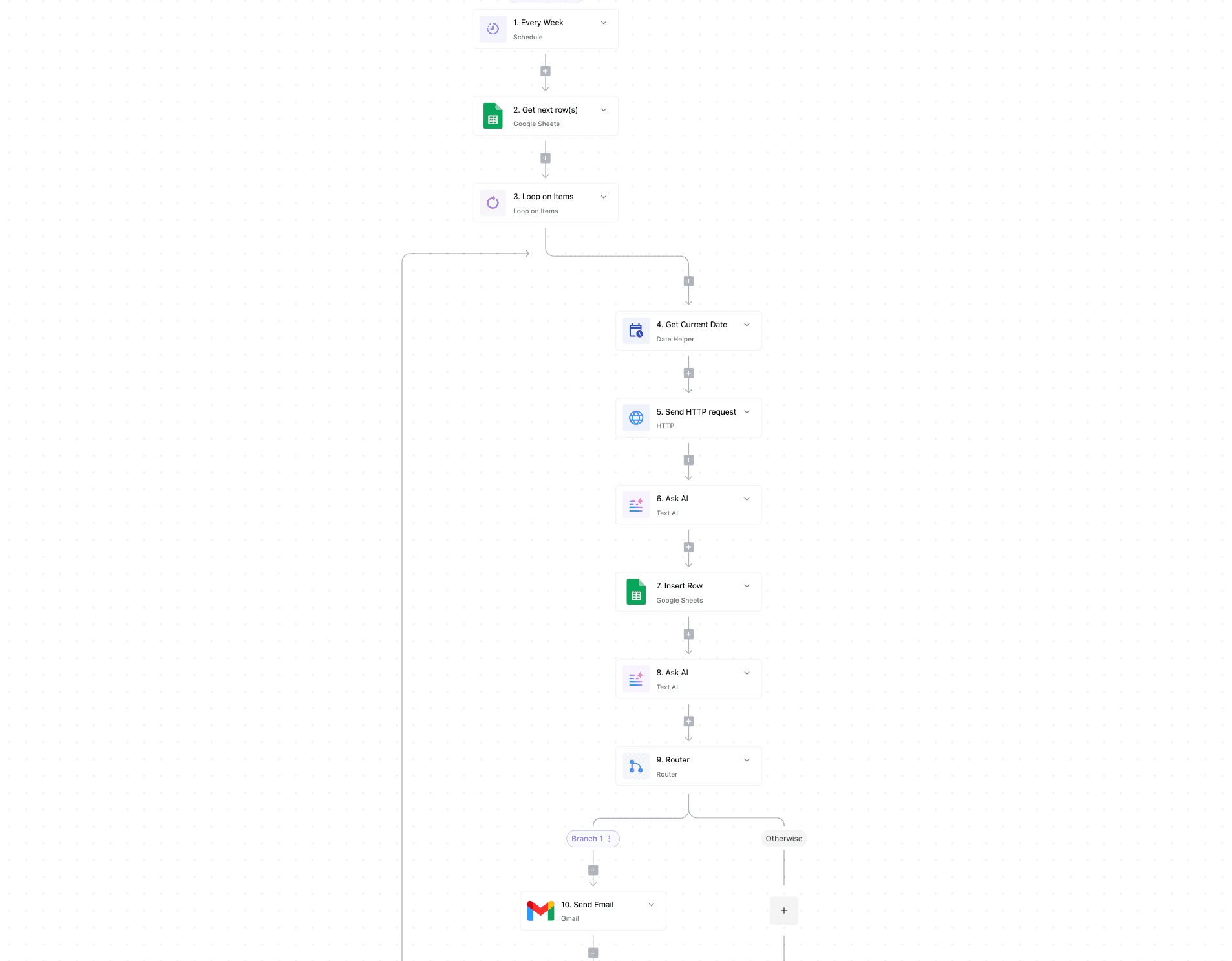
Activepieces allows you to create workflow automation without needing to write any code. It’s accessible for individuals without technical expertise.
It also lets your teams across various departments, such as marketing, sales, and operations, automate repetitive tasks easily, enhancing overall productivity.
Activepieces can be self-hosted, which gives you greater control over your data and workflows. That’s especially important for businesses concerned about data privacy and security.
You can deploy the tool on your own servers, making sure sensitive information remains within your premises.
Currently, Activepieces supports over 450 integrations. You can create complex workflows that synchronize data between applications, send notifications, and update records effortlessly.
As an open-source tool, Activepieces’ community contributes to its continuous improvement. It offers a free version and cost-effective plans with unlimited tasks. The potential for significant cost savings can lead to a strong return on investment (ROI) as you automate more processes.
Key Features
- AI automation – Create intelligent workflows that use AI agents, models, and natural language inputs to automate decision-making and tasks.
- Open ecosystem – Every integration is open source and available on npm, with 60% contributed by the community.
- Developer-friendly framework – Built in TypeScript for full flexibility, hot reloading, and easy customization of integrations.
- No-code builder – Drag-and-drop flow designer that empowers non-technical users to automate complex workflows without writing code.
- AI Copilot – Built-in assistant that helps users design and troubleshoot workflows faster.
- Enterprise-grade security – Supports self-hosting and network-gapped environments for complete control of business data.
- Human-in-the-loop – Includes approval steps and manual review triggers.
Integrations
As of today, Activepieces offers 450 pre-built integrations, a number that continues to grow rapidly through community contributions.

These pieces span major categories, including:
- OpenAI
- Slack
- Microsoft Excel 365
- Zoho CRM
- Microsoft Dynamics CRM
- HubSpot
- WordPress
- ActiveCampaign
- WooCommerce
- Zoho Books
- Google Sheets
- Microsoft Teams
Developers can create and publish their own integrations in TypeScript, which allows the ecosystem to expand continuously with each update.
Use Cases
Activepieces helps automate everyday workflows and AI-driven operations across industries:
- Marketing teams can use it to handle campaigns, CRM updates, and content scheduling.
- Human resources departments can automate onboarding, time-off requests, and internal approvals.
- IT and operations can streamline ticketing systems, alerts, and performance tracking.
- Data and analytics teams can integrate tools for real-time dashboards, reporting, and AI-assisted insights.
Its versatility allows both startups and large enterprises to save time, reduce manual effort, and centralize workflow automation.
Ready to automate your business end-to-end? Our sales team is here to help you get started!
2. Apache Airflow
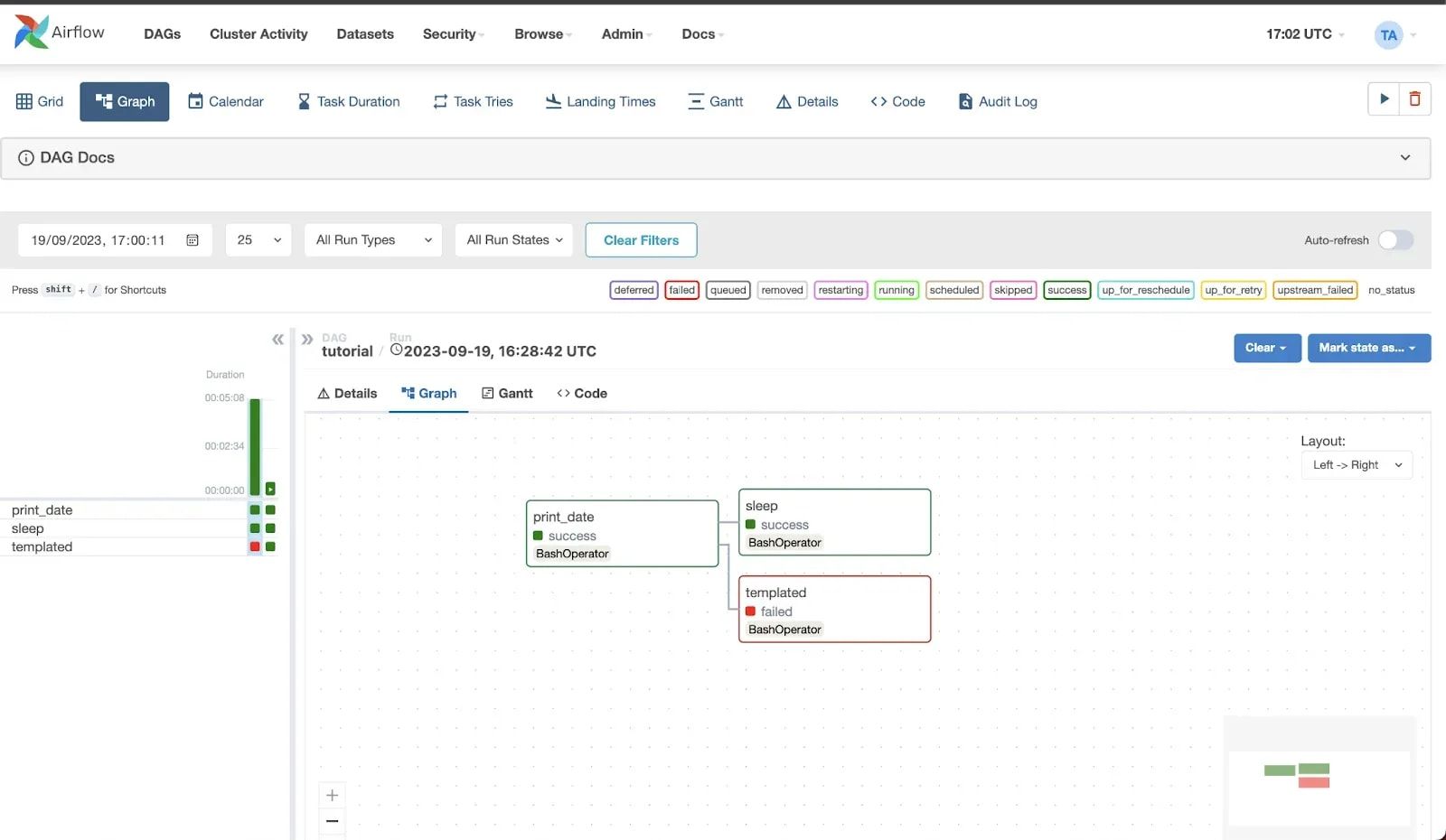
Apache Airflow is open-source workflow management software for data teams that manage large pipelines. It allows you to define workflows as code using Python.
You can dynamically generate pipelines and use Python’s flexibility to create complex workflows. That freedom helps automate ETL jobs and machine learning training steps without relying on multiple tools.
The platform’s modular setup includes a scheduler, executor, and workers that coordinate automating tasks. Each job runs in a defined order, which prevents human error and makes debugging straightforward.
The modular architecture uses a message queue to orchestrate an arbitrary number of workers, which makes it highly capable of handling workflows of any size. You can even monitor tasks and track performance through a clean web interface.
It also integrates seamlessly with many third-party services like Google Cloud Platform, Amazon Web Services, and Microsoft Azure. Supported by an active open-source community, it continues to evolve with frequent updates, so you can automate repetitive tasks better.
Key Features
- Dynamic workflow creation – Pipelines are defined in Python, which allows loops, conditions, and functions for reusable, testable workflows.
- Directed acyclic graphs – Tasks are structured in directed acyclic graphs (DAGs), making sure workflows run in the right order without circular dependencies.
- Rich web UI – The interface helps you monitor, debug, and manage workflows visually through grid and graph views.
- Extensibility – Custom operators, hooks, and sensors can be built in Python, enabling API integration.
- Reliability – Automatic retries, alerting, and detailed logging ensure workflow consistency and recovery.
- Integrations – Dozens of pre-built provider packages connect to platforms like AWS, GCP, Azure, and data systems.
Pros
- Python-based and familiar to data engineers
- Highly extensible with custom plugins
- Scales across distributed environments
- Large and active open-source community
Cons
- Steep learning curve for new users
- Not built for real-time or streaming tasks
- Limited built-in data quality checks
- Debugging across distributed systems can be slow
3. Camunda

Camunda is an open, cloud-native automation tool that connects people, systems, and decisions through visual modeling. It facilitates real-time collaboration using business process model and notation (BPMN) and decision model and notation (DMN).
Those two standards allow technical and non-technical teams to describe and automate business processes without confusion. For instance, you can draw clear diagrams, and your developers can turn those same diagrams into running workflows.
Due to Camunda’s orchestration layer, it links microservices, AI agents, and human approvals so you can automate task assignment and manage end-to-end processes on one engine. The Zeebe engine executes these customizable workflows.
It also facilitates collaboration and integration with other systems. Connectors let you integrate with software such as SAP, Salesforce, or REST APIs. It further has out-of-the-box connectors for universal orchestration, which makes it easy to integrate with various platforms and services.
For cross-functional collaboration, Camunda offers Tasklist, a web tool that brings your people into the loop. In addition, since it includes performance monitoring, alerting for important KPIs, and intuitive visualization of processes, you can optimize your workflows for better outcomes.
Key Features
- Cloud-native srchitecture – Built on Zeebe, Camunda supports distributed, event-driven automation for scalable performance.
- Resilience and fault tolerance – Data replication and cluster management ensure continuous availability and recovery.
- BPMN and DMN modeling – Enables visual, standards-based process and decision modeling that’s directly executable.
- Extensive integrations – Connects with systems, APIs, and enterprise agents for seamless process orchestration.
- Advanced monitoring and analytics – “Operate” and “Optimize” provide live process tracking, insights, and reporting.
- Human task management – Tasklist allows for assigning, tracking, and completing manual tasks alongside automation.
- AI orchestration – Integrates AI agents and decision-making under full audit control for transparency and compliance.
Pros
- Adheres to open standards (BPMN and DMN)
- Developer-friendly with API flexibility
- Real-time analytics and process visibility
- Backed by a global open-source community
Cons
- Requires technical expertise to master
- High-code setup compared to low-code tools
- Less intuitive for non-developers
- Some documentation lacks depth for advanced use cases
4. Imixs-Workflow

Imixs-Workflow is an open-source workflow engine designed for building business process management solutions with a focus on human-centric workflows. It uses the BPMN 2.0 standard for modeling business processes, so you can visually implement and modify business logic without coding.
The platform helps you design business workflows that rely on automation and human decision points. It manages task management through clear state transitions, automatically moving work items between users or departments.
Developers can add automation rules through their plugin system to handle validation, form processing, or system updates without building everything from scratch. This rich feature set helps reduce manual effort and improve overall coordination between systems and teams.
When you facilitate integration into modern application architectures, Imixs-Workflow supports deployment in containerized environments like Docker and Kubernetes.
Additionally, the associated Imixs-Office-Workflow suite enhances its capabilities with document management and office tool integration, so it’s widely used in industries such as finance and healthcare for regulatory compliance and case management.
Key Features
- Human-centric design – Prioritizes human-driven workflows, so you can always have the right information for timely decision-making.
- Low-code process modeling – Allows you to modify and model workflows with BPMN 2.0 diagrams without heavy coding or technical dependencies.
- Event-driven BPMN 2.0 modeling – Uses events, approvals, and reminders to trigger state transitions dynamically.
- Jakarta EE integration – Built on Jakarta EE for enterprise-grade scalability, security, and transaction management.
- Built-in security – Access controls and security policies can be embedded directly into BPMN models for transparent, rule-based protection.
- Plugin and adapter system – Extend functionality with custom plugins or adapters written in Java for advanced logic.
- AI integration – The Imixs-AI module enables LLM-powered decision-making and intelligent task routing within processes.
- Comprehensive module suite – Includes document management, archiving, and third-party system connectors for full enterprise coverage.
Pros
- Empowers non-technical users through low-code BPMN modeling
- Fully compliant with Jakarta EE for stability and scalability
- Easy integration via microservices and REST APIs
- AI-ready architecture for contextual automation
Cons
- Smaller user community compared to larger BPM platforms
- Advanced customization requires deep technical understanding
- Focused mainly on human-centric processes, not machine orchestration
- Less visibility and market presence than competitors
5. Bonitasoft

Bonitasoft is a digital process automation (DPA) and business process management platform that helps you build process-based applications to automate, manage, and optimize operations.
It bridges the gap between business and IT by combining low-code visual tools with developer-level customization.
Bonita Studio offers a visual interface for designing processes, which can be enhanced with custom code. That separation between visual and code-based development improves collaboration between analysts and developers.
The platform also minimizes manual data entry, standardizes repetitive steps, and supports complex workflows across departments.
It also supports continuous integration and deployment, and uses tools like Git, Jenkins, Docker, and Ansible. These integrations speed up delivery cycles and keep automation consistent across systems.
Through Bonitasoft’s centralized platform view, everyone stays aligned, and the dashboard provides a single point of view of project progress and status. By adopting Bonita Studio, organizations can automate processes, simplify collaboration, and cut down on manual effort.
Key Features
- Low-code and high-code approach – You can design workflows and UIs visually, while developers extend functionality with Java, Groovy, or APIs.
- Living applications – Creates complete, user-facing business apps with custom menus, pages, and forms directly linked to workflow tasks.
- BPMN 2.0 compliance – Uses the industry-standard modeling language to align your business and technical teams under a common visual framework.
- Built-in UI designer – Features a drag-and-drop interface with over 45 widgets for building responsive web applications.
- Seamless integrations – Offers pre-built connectors and supports custom integrations with CRMs, ERPs, and AI-based tools.
- Process monitoring and optimization – Provides real-time dashboards and analytics for performance tracking and improvement.
- Continuous delivery support – Enterprise editions include DevOps and CI/CD tools for faster deployments.
Pros
- Supports creation of full, process-driven business apps
- Integrates easily with both legacy and modern systems
- Transparent open-source foundation
- Encourages collaboration between business and IT
Cons
- Requires time to master advanced development features
- Java dependency may not suit all environments
- Enterprise features are limited to paid editions
- Built-in reporting lacks advanced analytics depth
6. CloudSlang
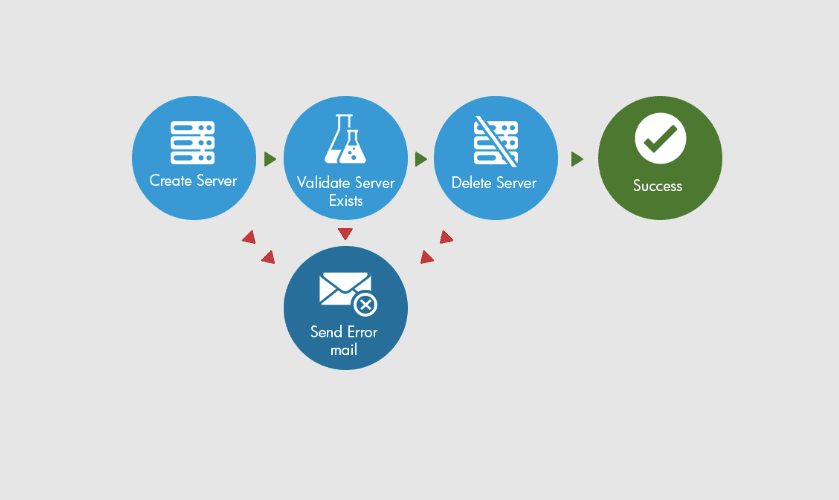
CloudSlang is an open-source orchestration tool designed primarily for DevOps and IT operations. It focuses on process-based automation instead of maintaining a “desired state.”
Each workflow in CloudSlang includes “flows,” “operations,” and “decisions” that define how tasks are executed and how data moves between steps.
The system uses a human-readable, YAML-based domain-specific language (DSL) to define complex processes, which makes it easier for developers and system administrators to design and manage automation logic.
The YAML structure lets you create your own workflows for DevOps automation or reuse templates from CloudSlang’s open library.
Meanwhile, the tool’s orchestration capabilities are especially beneficial for automating DevOps use cases. Whether it is continuous integration and delivery (CI/CD), infrastructure as code (IaC), or other routine IT operations, CloudSlang provides a platform to streamline these processes.
CloudSlang provides a lightweight, code-driven approach to orchestration that gives developers full control over how automated processes run and interact across systems.
Key Features
- Process-based orchestration – Focuses on process control instead of “desired state” modeling for precise automation for dynamic DevOps use cases like remediation and system health checks.
- YAML-based DSL – Uses a YAML-based language to define workflows.
- Agentless architecture – Executes workflows remotely without requiring agents on target machines.
- Lightweight embeddable engine (Score) – The core Java engine can be embedded in existing applications for seamless integration into enterprise ecosystems.
- Rich content library – Includes a GitHub-hosted library of reusable flows and operations for common DevOps tools like Docker, Jenkins, and OpenStack.
- DevOps-centric design – Built for automating tasks across IT operations, including provisioning, configuration, and application lifecycle management.
Pros
- Granular process control for complex DevOps workflows
- Agentless architecture simplifies deployment and enhances security
- Lightweight Java engine that integrates with existing applications
- Large open-source library of reusable content and connectors
Cons
- No graphical modeler for visual workflow design
- Requires technical expertise to create and debug flows
- Primarily focused on IT automation, not business processes
- Lacks a built-in web UI for process monitoring and management
7. Activiti
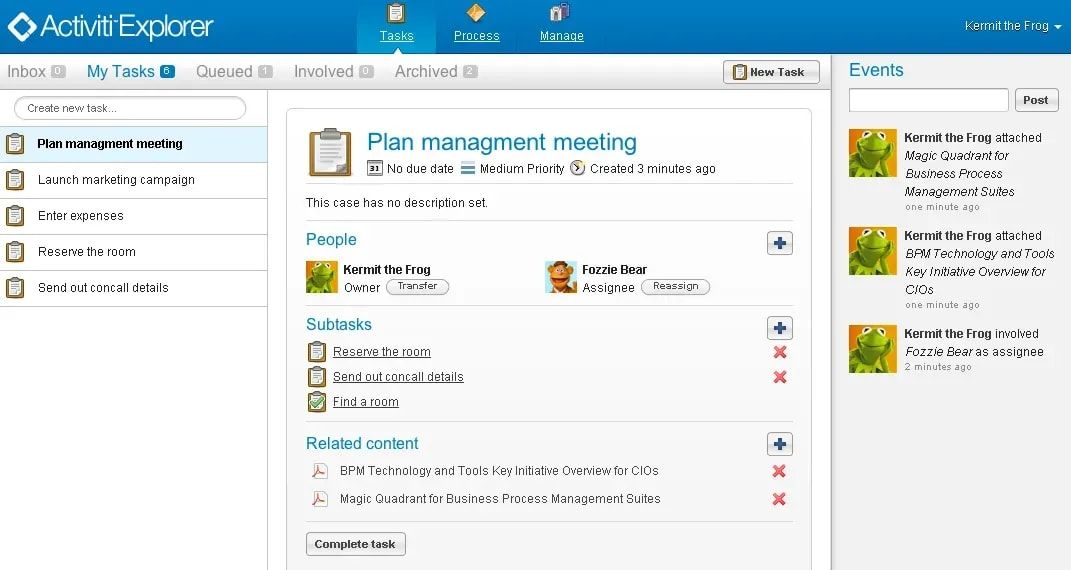
Activiti is an open-source workflow and business process management platform built in Java. Since it’s Java-centric, it ensures seamless integration with other Java applications and frameworks.
Each process starts as a visual BPMN model, which is deployed to the Activiti engine. Once active, the engine coordinates steps such as human approvals, data synchronization, and automated actions across multiple systems.
These automated workflows replace manual processes, reducing delays and improving accuracy.
Additionally, Activiti can run in various environments: a single server, a clustered setup, or the cloud. The modular architecture of Activiti also means that you can extend and modify the platform as needed, which makes sure it evolves alongside your requirements.
Key Features
- Lightweight and embeddable – The process engine can be seamlessly embedded into any Java application, from standalone deployments to distributed cloud environments.
- Java-centric APIs – Offers a rich set of Java APIs for managing workflows, starting process instances, and querying tasks programmatically.
- Spring integration – Natively integrates with the Spring and Spring Boot frameworks.
- Task management – Provides tools for assigning and tracking human tasks through its Tasklist UI or REST API.
- Extensible architecture – You can add custom activities, event listeners, or scripts to extend functionality and implement specialized business logic.
- Monitoring and reporting – Includes APIs for real-time process tracking, reporting, and performance analysis to identify inefficiencies and optimize workflows.
- Cloud-native components (Activiti Cloud) – Features modular services like Runtime Bundles, Query Services, and Audit Services for distributed, cloud-ready deployments.
Pros
- Completely open source and free under the Apache license
- Lightweight engine that integrates easily with Java apps
- Comprehensive Java APIs and native Spring support
- Standards-based BPMN 2.0 compliance
Cons
- No guaranteed enterprise-level support
- History of forks leading to community fragmentation
- Hidden infrastructure and maintenance costs
- Limited simulation and analytics compared to commercial BPM suites
8. ProcessMaker
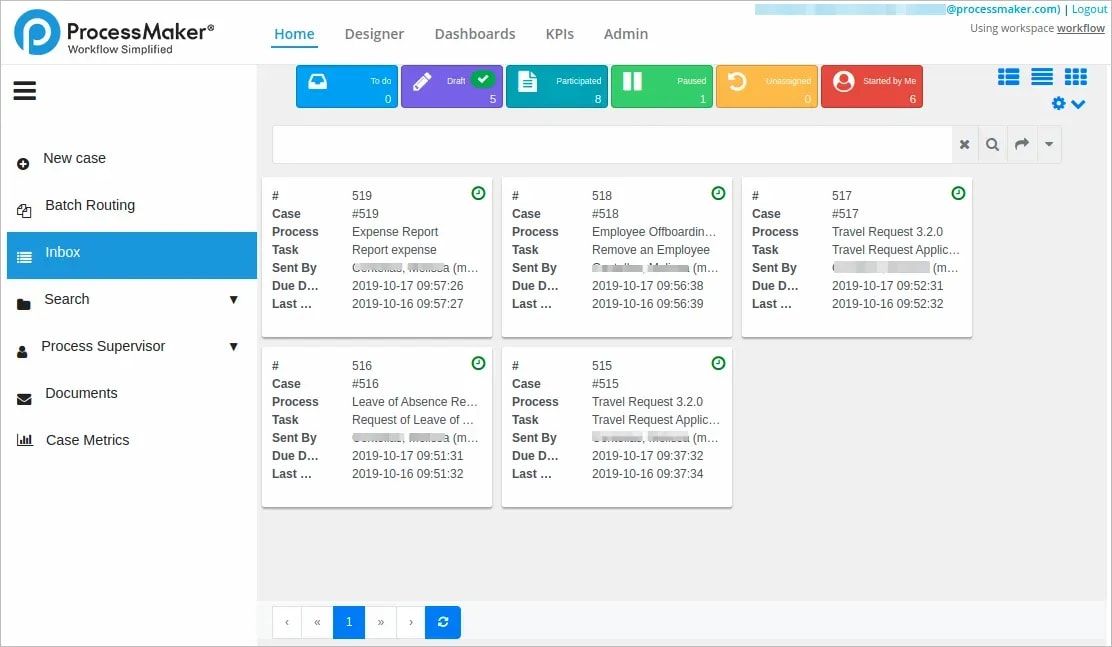
ProcessMaker is a low-code, intelligent BPM and digital process automation platform to design, automate, and optimize simple processes and tedious tasks. It adheres to the BPMN 2.0 standard, which makes sure that your workflows are compatible with industry standards.
The platform includes a form builder that lets you create custom forms to capture data at various stages of your workflow. You can assign roles and permissions to different users, so that only authorized personnel can access specific parts of the workflow.
Built-in controls simplify collaboration and maintain security. ProcessMaker can even integrate with various third-party applications that you can incorporate into your existing tech stack. Integrations connect with ERP, CRM, and AI systems to support smarter automation.
The project dashboard provides insights into workloads and bottlenecks, while intelligent reporting provides version control for processes, forms, and documents.
With a strong open-source community, ProcessMaker gives you full flexibility to evolve and improve your automated workflows.
Key Features
- Intelligent document processing – AI automatically extracts and processes data from documents, turning unstructured content into usable insights for industries like finance and healthcare.
- Generative AI – Allows you to generate entire workflows, forms, and scripts from text or images, dramatically accelerating design and reducing manual setup.
- Agentic AI (Genies) – Custom-trained AI agents automate repetitive tasks, make intelligent decisions, and learn from organizational data to improve over time.
- Data integrations – Offers pre-built connectors and APIs for CRMs, ERPs, and other enterprise tools to unify processes across departments.
- Real-time monitoring – Interactive dashboards let you track performance and identify bottlenecks instantly.
- Comprehensive security – Role-based access and audit trails ensure compliance and data protection.
- Mobile access – A dedicated app allows users to review, approve, and manage tasks on the go.
Pros
- Intuitive low-code design accelerates process creation
- AI-driven features like IDP and Generative AI boost automation speed
- Real-time performance tracking and analytics tools
- Mobile-friendly interface for remote work flexibility
Cons
- Performance can lag with very complex or large workflows
- Limited native reporting compared to advanced BI tools
- Occasional inconsistencies in customer support response
- The user interface could benefit from modernization
9. StackStorm
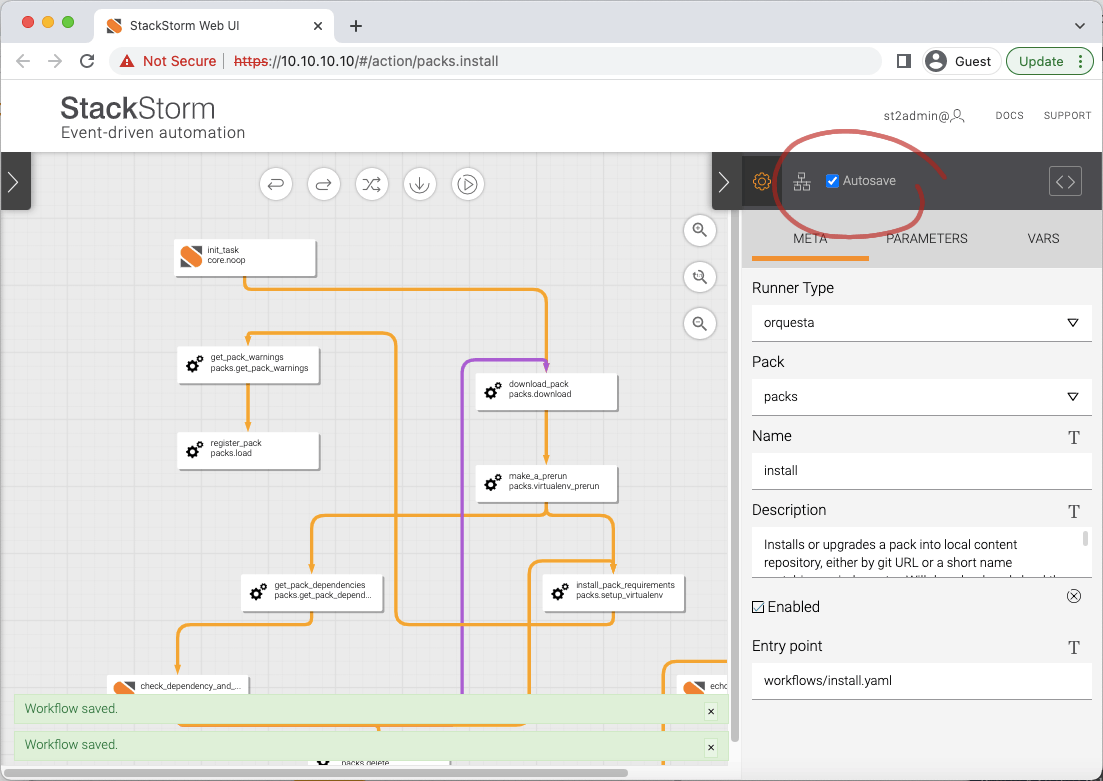
StackStorm is an open-source, event-driven automation platform designed to streamline and automate various IT operations. It follows an if-then model where sensors detect events, rules define logic, and actions execute automated responses.
The system runs on a microservice architecture with distributed execution, so it scales across servers and manages thousands of manual tasks automatically. Using sensors, triggers, and rules, you can automate responses to events such as system alerts, CI/CD changes, or security incidents.
Its architecture also supports distributed execution, which makes sure it can handle high loads. The built-in Orquesta engine manages advanced workflows, letting users design automation that spans from simple commands to multi-step sequences.
That flexibility supports cross-functional teams, where developers, system admins, and security engineers collaborate on automation through a shared interface.
As an open-source tool, StackStorm has a vibrant community of users and contributors. That community ensures active development, continuous improvement for simple and complex processes, and a wealth of shared knowledge.
Key Features
- Event-driven automation – Operates on an if-then logic using sensors, triggers, and rules. Sensors listen for events across systems, triggers capture them, and rules determine which actions or workflows should execute in response.
- Orchestration engine (Orquesta) – Handles complex workflows with branching, joining, and error recovery.
- Rich content library (Packs) – Uses modular packs to organize related automations and integrations.
- ChatOps integration – Connects directly with platforms like Slack and Mattermost. Teams can trigger workflows, execute commands, and receive feedback in chat.
- Detailed audit trail – Records every action, workflow, and result, providing complete visibility for debugging, compliance, and security reviews.
Pros
- Real-time, event-driven automation for IT and DevOps
- Infrastructure-as-code model with YAML-defined workflows
- Native ChatOps functionality for collaboration and visibility
- Transparent audit trails for compliance and troubleshooting
Cons
- A steep learning curve for beginners and non-developers
- No graphical workflow modeler for visual design
- Some community-maintained packs may lack consistent updates
- Limited official enterprise support, relying primarily on the open-source community
10. Kubeflow Pipelines
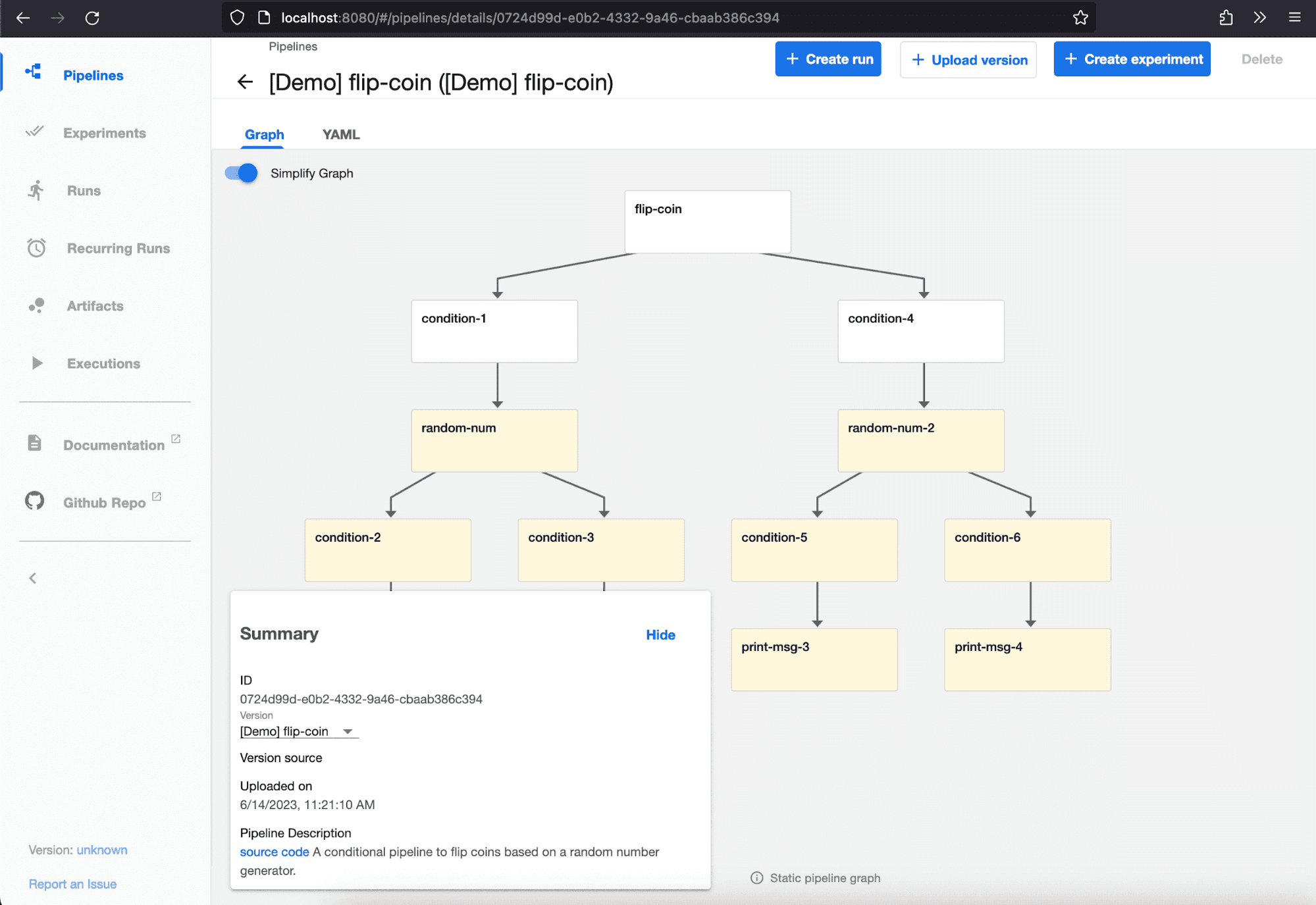
Kubeflow Pipelines is an open-source platform that helps teams design, deploy, and manage workflows for machine learning projects. Built on Kubernetes, it uses containerization to make every step of a machine learning pipeline portable and reproducible across environments.
Each workflow runs through a DAG model, which defines the order of operations, from data ingestion to training and evaluation. The DAG layout makes it easier to design both simple and more complex tasks, keeping every stage modular and transparent.
On top of that, Kubeflow Pipelines can handle end-to-end orchestration of ML workflows. The platform coordinates data preparation, training, validation, and deployment under one system to reduce the need for manual tasks.
Kubeflow’s interface also enables users to visualize experiments, compare results, and debug workflows efficiently. Then the built-in dashboard helps track performance and resource usage across runs, which makes it easy for remote teams to collaborate.
You can further create custom ML components or leverage an existing ecosystem of components, which can be easily integrated into your workflows. Though it has a steep learning curve, Kubeflow Pipelines provides a foundation for teams building workflows in AI and ML development.
Key Features
- Python SDK for intuitive authoring – Empowers data scientists to create, test, and manage ML workflows directly in Python using decorators.
- Containerized components – Each pipeline step runs as an independent container.
- Metadata tracking and lineage – Automatically logs inputs, outputs, and execution details, which allows full visibility into datasets, models, and parameters for reproducibility and auditing.
- Caching for efficiency – Detects identical inputs and skips redundant steps, drastically reducing iteration time and computing costs during experimentation.
- Platform-neutral YAML format – Pipelines compile into portable YAML, making sure workflows can move seamlessly across environments and cloud providers.
- Advanced control flow – Supports conditional logic, loops, and failure handling for building resilient and complex ML workflows.
Pros
- Promotes reproducibility with containerized components and lineage tracking
- Caching improves speed and reduces resource consumption
- Fully open-source and vendor-neutral for maximum portability
- Familiar Python SDK simplifies pipeline development
Cons
- Requires strong Kubernetes knowledge
- Complex setup and maintenance with potential dependency issues
- Documentation can be limited or outdated for some versions
- Resource-heavy for small teams or low-scale workloads
Build AI Workflows and Automate With Activepieces

Activepieces is the AI-powered automation tool for everyone, from solo creators to enterprise teams. Even without technical knowledge, you can automate workflows.
With its user-friendly interface, you can drag, drop, and connect pieces to create intelligent workflows that manage data, trigger actions, and interact with AI tools in real time.
Developers can customize and extend these pieces in TypeScript, while business users enjoy ready-to-use integrations straight from npm.
The platform’s automation capabilities further span across marketing, operations, human resources, and data analysis. From approving leave requests to generating reports or connecting CRM and AI services, Activepieces turns manual routines into seamless, automated systems.
You can also self-host to keep your data private. Every feature, from AI Copilot assistance to built-in human approval steps, makes sure you stay in control.
Step into the age of autonomous automation with Activepieces. Try today!
FAQs About Workflow Automation Software
What is the best workflow automation software?
The best workflow automation software right now is Activepieces. It helps project managers and multiple teams automate routine tasks, connect hundreds of apps, and track progress in real time.
Activepieces uses AI and machine learning to create intelligent workflows while keeping everyone on the same page across projects and departments.
What is workflow automation software?
Workflow automation software is a platform that automates repetitive or manual business processes.
Is Zapier an AI workflow automation tool?
Zapier is primarily a workflow automation tool, not an AI workflow automation platform. It automates app connections and tasks but lacks native AI or machine learning capabilities for intelligent decision-making.
Does Microsoft Office have a workflow tool?
Yes. Microsoft offers a workflow tool through Power Automate, which integrates with Office 365 apps like Outlook, Excel, and Teams.


